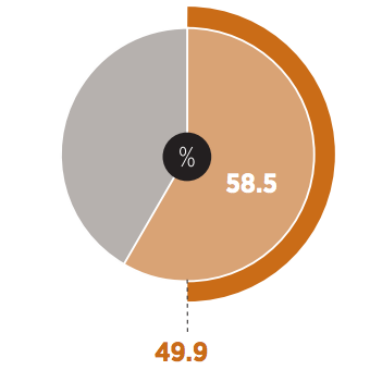How bosses and workers see the federal workplace

A new report says a dangerous disconnect exists at several agencies -- and aligned views do not necessarily point to a happy workplace.

The question of whether employees' workloads are reasonable was one of only two in the survey where workers' views (inner pie chart) were more positive than managers' (outer band).
What: "Positioned for Change: Understanding Staff/Manager Alignment" from the Partnership for Public Service.
Why: Federal managers and employees do not necessarily view their organizations the same way. Managers typically have more positive impressions of workplace culture and tone than rank-and-file employees do. But extremely divergent impressions of the workplace can point to problems, according to the Partnership for Public Service's analysis of Federal Employee Viewpoint Survey data.
Across government, divergent views are found in areas of fairness and equity, with nearly half of managers believing that promotions are based on merit while barely a quarter of employees say the same. That is perhaps unsurprising given that many of the surveyed staffers might have sought and been denied promotions, and those same employees have a different impression of managerial merit than do the managers themselves.
Employees and managers also have strikingly different views on the impact of partisan politics in the workplace and employees' opportunities to take on leadership roles.
The partnership has created a metric to measure the divergence between employees' and managers' views on an agency-by-agency basis. A negative score means an unusually large gap. The Securities and Exchange Commission had the lowest score, with -36. Other low-scoring agencies include the Equal Employment Opportunity Commission (-29), the National Archives and Records Administration (-26), the Education Department (-25) and the National Science Foundation (-24). The Labor Department and the Social Security Administration were the only large agencies to post negative scores.
Top performers include the Commerce Department (38), the Agriculture Department (35), the State Department (35) and the Navy (29).
It is interesting to note that an agency's overall score on the partnership's Best Places to Work in the Federal Government list does not necessarily match staff/manager alignment. Some agencies with the most divergent staff and manager perceptions scored in the mid ranks on the Best Places list, as did several agencies with high staff/manager alignment scores. In other words, just because employees and managers share similar views of the workplace, it doesn't mean what they're seeing is good.
Verbatim: "Of the 44 questions included in this Best Places to Work analysis, staff responded more positively than managers in only two instances. More employees feel that their workloads are reasonable (an 8.6 point gap between staff and managers) and that they have sufficient resources to get their jobs done (a 9.3 point gap). These findings could indicate that managers are feeling a great deal of stress in trying to accomplish their mission goals with limited resources."
Full report: OurPublicService.org



